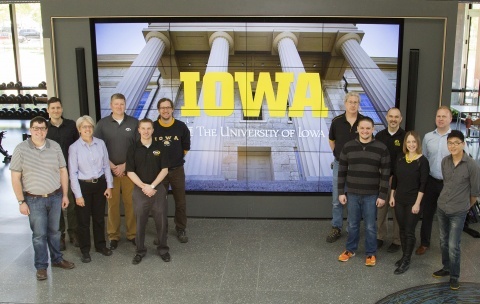
The switch to a tiny but mighty compute stick is saving departments time, money and hassle when it comes to powering digital signage across campus.
Digital signage, also described as electronic billboards, plays a critical role in displaying important information and announcements in buildings throughout the UI campus. As part of a OneIT@Iowa Website Hosting sub-project, more than 32 departments representing 70 different units on campus have adopted a free and easy-to-use digital signage service based on Drupal, the predominate web content-management system (CMS) on campus.
As more units embraced the new Drupal Signage Service, the project team discovered a new, efficient way to power digital signs: small, reliable, and easy-to-maintain Intel Compute Sticks. To date, 187 of the sticks are deployed—83 of which were provided through a hardware exchange program that allowed Drupal Digital Signage customers to trade in aging, less efficient computers for the new sticks.
Isaac Podolefsky, IT project manager for the College of Liberal Arts and Sciences, identified the sticks as a solution. He says standardizing hardware provides an easier support model and the UI saves money buying the sticks, which cost far less than a PC, in energy, and in cabling costs, since the units use wireless. Each compute stick saves approximately $150 per year over a desktop.
“The sticks are easier to maintain because they are programmed to detect issues and automatically reboot and kick out an email if there’s an issue with a sign,” Podolefsky says. “And, if there is an error that the sticks cannot self-correct, IT professionals can typically triage the problem remotely.”
He added that creating a more streamlined system for managing signage across campus has already begun to save staff time by simplifying the deployment and maintenance process.

About the size of a small TV remote, the compute sticks use a fraction of the energy (16 kwh) in comparison to the power used by a full-scale computer (200 to 300 kwh). Those power savings level off to about $4 per device per year in energy costs, while maintaining the ability to power scrolling feeds, animations, videos, and running multiple displays at once. The Campus Recreation and Wellness Center, for example, has a video wall with 16 (4x4) video displays running off of just one compute stick.
The compact wireless compute sticks are also much easier to mount on a wall than their predecessors.
“There really aren’t a lot of devices that can fit in a space this small,” Podolefsky says, referencing the space between a wall and a flat-screen TV. “In a couple of locations, we had to build shelves to hold a desktop tower under a display and then run cables. But this can be challenging, too, because our buildings are historic and there are very specific requirements for any additions or changes. Because the compute stick plugs and plays right into the back of the display, we don’t need any additional room.”
Users say they’re already experiencing success with the system.
Brandon Mills, IT director for UI Housing and Dining, says his department has over 30 digital signs in residence halls across campus and the sticks have been much easier mount, use, and maintain.
“The compute sticks are not only cheaper, but seem to be infinitely more stable hardware to run our signs on,” Mills says. “They don’t require figuring out a crazy mounting bracket solution and we didn’t have a single instance where we didn’t have space between the TV and the wall.”
The hardware exchange program has concluded, but departments interested in switching to Drupal Digital Signage or using compute sticks can reach the Digital Signage Team at ui-signage@uiowa.edu.